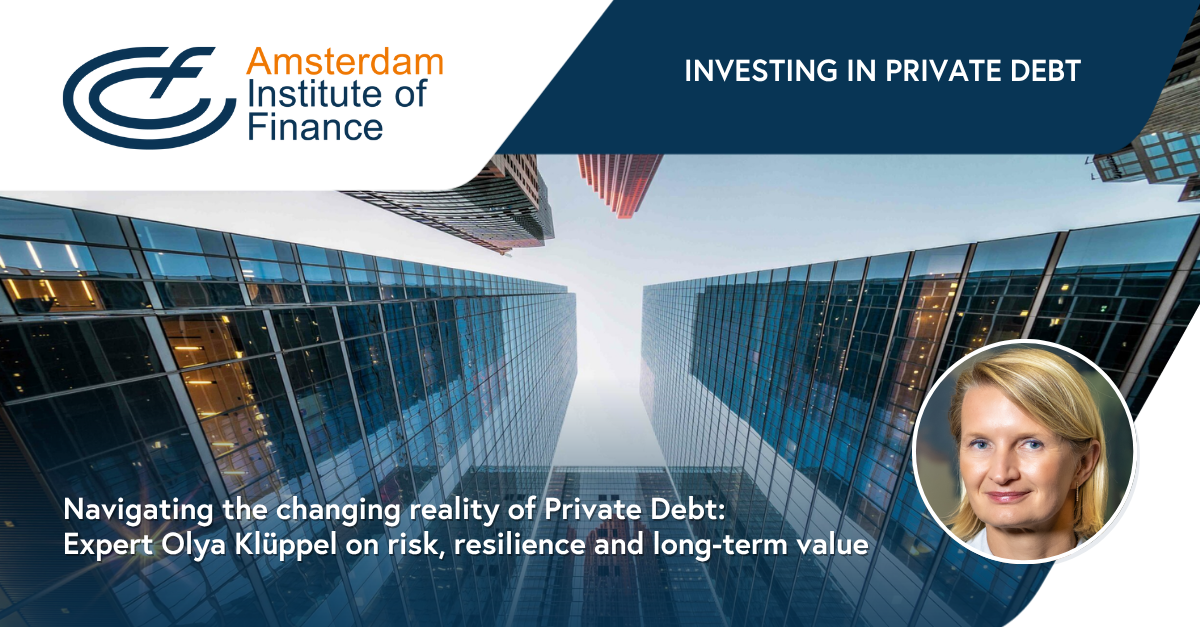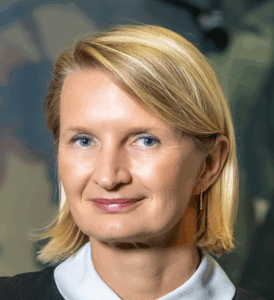
How private credit is evolving from niche to core asset class, and why the next phase will reward specialization, discipline, and genuine value creation.
Private debt has moved from the margins to the mainstream. Over the past decade, the asset class has grown into a central pillar of institutional portfolios, offering yield, diversification, and downside protection in a changing rate environment. Amid increasing commoditisation, intensifying competition, and loosening structures, success in private credit has shifted from pursuing scale to mastering complexity.
Few experts understand this balance better than Olya Klüppel, Managing Partner and Co-Founder of Global Growth Capital, with more than 20 years of investment experience across public and private markets in Europe, Asia, and the U.S. Together with Professor Cyril Demaria, she co-teaches the AIF program Investing in Private Debt.
In this interview, Klüppel reflects on the structural shifts reshaping private credit, the blind spots that persist in due diligence, and the mindset required to navigate risk and opportunity through cycles.

“True resilience comes from making the right investment decision combined with appropriate diversification, disciplined liquidity management, and never outsourcing control of your own risk.”
– Olya Klüppel, Managing Partner & Co-Founder, Global Growth Capital
From banks to funds: a new era in capital flow
“Private debt’s rapid ascent reflects a structural shift in how capital is intermediated,” Klüppel begins. “Following the global financial crisis, regulatory constraints such as Basel III and IV curtailed banks’ appetite for corporate lending. This paved the way for alternative lenders to fill the funding gap. The rise of private debt was then solidified by the COVID-19 pandemic: the mark-to-market volatility that spooked investors in liquid markets wasn’t a factor for private credit. A wide range of borrowers were able to get rapid execution and enhanced flexibility of private credit loans which were not available through banks or public capital markets.”
“Institutional investors, facing low yields and a need for predictable income, stepped in,” she continues, “as they were attracted by the illiquidity premium, diversification, and generally stronger creditor protections private credit offered at the time.”
As the asset class matures, she expects private credit to become a permanent counterpart to the banking system rather than its shadow. “Banks will originate and distribute, while funds will increasingly hold, structure, and manage risk for institutional capital. I believe private and public credit markets are settling into a symbiotic coexistence: this is particularly pronounced in the U.S. where the distinctions between direct lending and broadly syndicated loans increasingly disappear.”
In addition, she predicts that as more and more institutional investors enter the market directly, the boundaries between lender, investor, and asset manager will continue to blur, driving deeper specialization, more bespoke solutions for borrowers, and ultimately a more diversified and resilient credit ecosystem.
The blind spots of private credit investors
With experience spanning leveraged finance, fixed income, and special situations, Klüppel has seen patterns repeat across cycles. “A recurring pitfall is the assumption that larger equals safer,” she cautions. “Investors are often persuaded by scale. But with size comes complexity, weaker control, and diluted relationships. The recent First Brands bankruptcy underscored how the race to deploy large pools of capital can erode underwriting discipline.”
Geography is often misunderstood. “Another misconception is that the U.S. market is inherently safer than Europe. While the U.S. offers greater market depth and liquidity, its efficiency favors borrowers, not lenders. Fierce competition often forces managers to stretch on pricing or loosen covenants just to win deals. In contrast, Europe’s less efficient and more fragmented markets, which incorporate cultural nuances and a heterogeneous legal and regulatory landscape, offer better opportunities to lenders with experience in navigating such an environment.”
Finally, liquidity assumptions are another blind spot. “Many investors tend to overestimate the liquidity of public markets, highlighting lack of liquidity as the reason not to invest in private credit. Periodic volatility shows that “liquid” credit can become illiquid when stress hits. Related, structured liquidity solutions in private credit often overpromise. While under normal market conditions it is possible to structure complex distribution waterfalls with gating and other features to provide a degree of liquidity, private credit should be treated, and transparently communicated, as a fundamentally illiquid asset class, especially when marketed to high-net-worth and particularly retail investors.”
Program highlight: Investing in Private Debt
Together with Professor Cyril Demaria, Olya Klüppel co-teaches Investing in Private Debt at the Amsterdam Institute of Finance. This intensive two-day program bridges theory and practice through case studies, portfolio simulations, and applied exercises, helping participants translate insights directly into investment action. Learn more & enroll
Investing in Private Debt is part of AIF’s Investing in Private Markets Series.
From structure to strategy: insights from the AIF classroom
In the Investing in Private Debt program, Klüppel and Professor Demaria guide participants through the mechanics of private credit, from direct lending and specialty finance to distressed and asset-backed financing.
“Participants will gain a practitioner’s lens for assessing private credit strategies,” she explains. “We focus on how structure drives outcome, linking the instrument, borrower profile, and risk mitigation tools to expected return and loss behavior. We introduce frameworks for evaluating credit quality, assessing downside protection, and distinguishing between cash-flow, asset-backed, and special-situations models.”
“Equally important,” she adds, “participants learn to analyze the alignment between fund structure and strategy, understanding how leverage, liquidity terms, and fee design affect investor outcomes. The goal is to help investors ask sharper questions: Where is value created? Are my incentives aligned with those of the lender? By demystifying private credit mechanics and risk calibration, the program equips participants to identify genuine edge versus financial engineering, and to invest in private credit with greater confidence and strategic intent.”
“A recurring pitfall is the assumption that larger equals safer. With size comes complexity, weaker control, and diluted relationships.”
Why discipline beats scale in the new cycle
Asked about the most resilient strategies in today’s environment, Klüppel points to the fundamentals. “Private credit, in both Europe and the U.S., is at an inflection point. The dominant segment, direct lending, has become increasingly commoditized and intermediated, with debt advisors circulating standardized term sheets to multiple providers. As spreads tighten and structures weaken, the segment risks delivering index-like returns without index-like liquidity.”
The edge, she says, lies elsewhere. “Meaningful opportunities remain for differentiated managers. The most resilient strategies are those grounded in true proprietary origination cultivated through long-standing borrower relationships and the ability to deliver value beyond capital. Equally critical is an integrated risk management framework, where risk assessment is embedded in the investment process rather than delegated to a separate control function. Finally, culture matters: firms that foster open dialogue, align incentives for long-term success, and encourage collective accountability make better decisions through cycles.”
“These fundamentals, not leverage or scale, will define outperformance in the next phase of private credit,” she says firmly.
Lessons from experience: leverage, control, and character
Reflecting on past crises, Klüppel recalls one of the most valuable lessons. “During the global financial crisis, I watched a fund that made the right call on subprime mortgages collapse. This was not because of poor judgment, but because of excessive leverage and dependence on a single counterparty – in that specific case, a bank – whose incentives ultimately diverged. It was a stark reminder that even a sound investment thesis can fail if operational and structural risks are ignored.”
“Leverage can amplify returns, but it also magnifies fragility, especially in illiquid markets,” she says. “True resilience comes from making the right investment decision combined with appropriate diversification, disciplined liquidity management, and never outsourcing control of your own risk.”
Meet the expert
Olya Klüppel, Managing Partner & Co-Founder, Global Growth Capital
With over 20 years of experience across public and private markets, Olya Klüppel has led fixed-income and special-situations strategies in Europe, Asia, and the U.S. She began her career at Salomon Smith Barney (currently Citigroup) in New York as well as Tokyo and London, and later managed portfolios at Harcourt (Vontobel) and ESO Capital before co-founding Global Growth Capital. She holds an MBA from Harvard Business School.
Discover Olya Klüppel’s expertise and programs
About the Investing in Private Markets Series
AIF launches a new series of executive programs in spring 2026: Investing in Private Real Estate, Investing in Private Debt, and Investing in Private Infrastructure. At the heart of the series is Cyril Demaria, one of Europe’s foremost thinkers on private markets and author of multiple reference works, including Introduction to Private Equity, Debt and Real Assets and Asset Allocation and Private Markets. Explore the new Investing in Private Markets series:
1. Investing in Private Real Estate
With Prof. Cyril Demaria & Zoltan Szelyes
Gain an edge in selecting funds and assets with state-of-the-art practice:
✔ Understand how private real estate creates value in portfolios
✔ Gain insight into fund structures, strategies, and performance metrics
✔ Apply valuation methods to spot opportunities across global markets
Learn more & enroll
2. Investing in Private Debt
With Prof. Cyril Demaria & Olya Klüppel
Position for success in a fast-growing sub-asset class with insights that work:
✔ Understand private credit: grasp strategies, structures, and instruments shaping today’s market
✔ Bridge theory and practice: use frameworks and cases to assess opportunities, risks, and impact
✔ Think like an investor: position private credit for stronger diversification and returns
Learn more & enroll
3. Investing in Private Infrastructure
With Prof. Cyril Demaria & Tim Whittaker
Build expertise in infrastructure funds and investments through best-in-class knowledge:
✔ Understand the full value chain of private infrastructure investing, from strategy to valuation
✔ Master core strategies and tools to navigate global infrastructure markets
✔ Apply institutional insights into fund structures, performance, and portfolio construction
Learn more & enroll
Learn from the experts shaping the future of private markets. Explore the full series or contact AIF for personal advice: +31 20 246 7140 |info@aif.nl